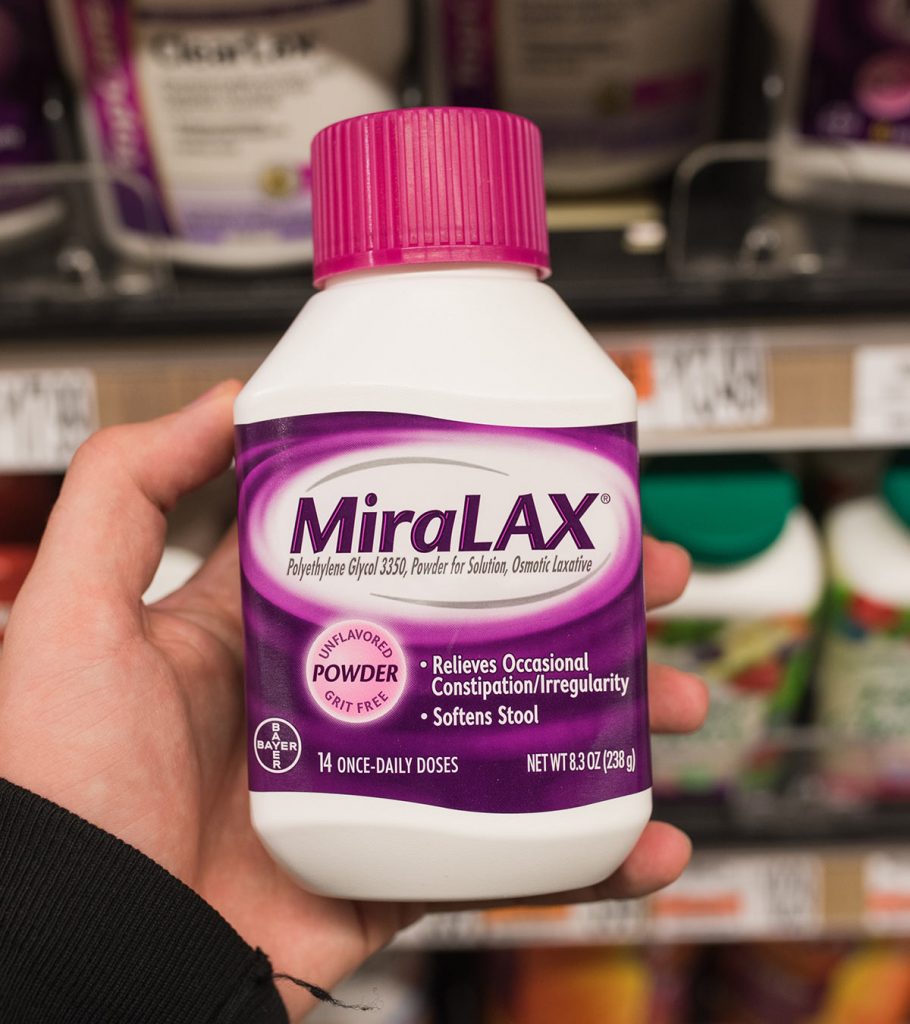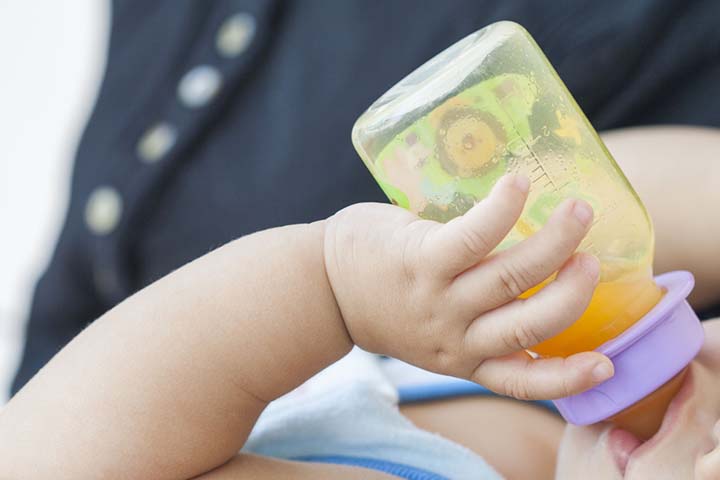MiraLAX for kids is not often recommended since the US Food and Drug Administration (FDA) does not approve its use due to a lack of clinical trials in children. However, some randomized control trials have shown it to be safe and effective for occasional pediatric use, so doctors may prescribe it to treat constipation in children in some countries, depending on the clinical guidelines. Children can have abdominal pain, lack of appetite, and bloating in constipation. Less than three bowel movements in a week for a few weeks is considered chronic constipation (1). Dietary changes and laxatives, such as MiraLAX, could be given to children with constipation. Read on to know the safety and side effects of Miralax for children.
What Is MiraLAX?
MiraLAX is the brand name for the generic compound polyethylene glycol 3350 (PEG 3350). This substance belongs to the osmotic laxatives category, which acts as a stool softener by retaining water in the colon, thus increasing the stool volume and triggering the defecation reflex (2)
PEG 3350, the medicinal component in MiraLAX, is a solution without added electrolytes; it is odorless, and carries no risk of electrolyte imbalance. This is readily soluble, and only small amounts are absorbed into the gastrointestinal tract (3)
Is MiraLAX Made From Natural Ingredients?
Polyethylene glycol, which is the active component in MiraLAX, is chemically-derived but is free of gluten, sugar, and preservatives (4).
Is MiraLAX Safe For Infants And Children?
According to a research paper published in the Canadian Family Physician, the active component PEG 3350 in MiraLAX is considered a safe and effective long-term laxative for the pediatric population. However, the study adds that little is known about the safety of this medicine for children less than two years old (3).
It to be noted that the manufacturer of MiraLAX recommends it only for children above the age of 17 years. Doctor’s advice is required for use among children below the age of 16 years (5).
Further studies (6) (7) claim that PEG 3350 is safe for children and infants younger than 18 months old to relieve chronic constipation. But, in 2017, some families claimed that MiraLAX caused psychological disturbances in children. This event led the US Food and Drug Administration (USFDA) to receive several petitions asking for an evaluation of MiraLAX’s safety for children (8).
USFDA then granted a study to The Children’s Hospital of Philadelphia’s (CHOP’s) Division of Gastroenterology to determine if PEG 3350 or its components can cause neurological disturbances in children.
PEG 3350 Study By The Children’s Hospital of Philadelphia (CHOP)
The hospital stated that they are in the first phase of the study. It further advises that until they could conclude on the effects of PEG 3350 in children, parents should talk to their child’s pediatrician regarding the use of MiraLAX (9).
Another research paper analyzed multiple bits of data, including that from USFDA, Google Trends, and surveys of US pediatric gastroenterologists. The study found that the PEG aversion reported by caretakers was real, but added that there could be limitations such as over-reporting. It could not be established if the alleged symptoms among children were pre-existing or triggered by MiraLAX. The researchers also stated that the change in behavior among non-verbal children might have been perceived as neuropsychiatric disturbancesiXMedical conditions involving both neurological and psychiatric disorders, such as seizures, depression, anxiety, and schizophrenia. (10).
The study did acknowledge the limitations of the sources of information. As the historical studies and anecdotal evidence are conflicting, the question of MiraLAX’s safety will be under question until the CHOP study is completed. So, it is best to talk to your pediatrician before using MiraLAX for your child.
When Can Children Have MiraLAX?
If you have detected your child’s constipation early, then your pediatrician might ask to try some non-medical ways to relieve constipation. However, if the constipation is severe, then the child might require their bowels washed followed by a prescription of MiraLAX dosage. You will need to observe the MiraLAX regime as prescribed by the doctor. Children thus may have MiraLAX when dietary changes fail to work (11).
How To Give MiraLAX To Children?
If your doctor has prescribed MiraLAX for your child, then here are the steps on how to administer it.
- It is better to mix MiraLAX with water. But the manufacturer advises consulting a doctor for dosage instructions for children below the age of 16 years (12).
- Let the cup sit for a minute so that the powder is completely dissolved.
- Make the child drink the entire first dose of MiraLAX within 30 minutes.
- The next dose could be administered every 1-2 hours until the stools become clear and do not contain chunks.
- Do not wake up your child at night to administering MiraLAX(13)
A doctor may prescribe a dosage different from the steps above or even the steps on the pack of MiraLAX. Follow the doctor’s recommended dosage method and give the prescribed dose to prevent overdosing.
Can You Give PEG With Electrolytes To Children?
Polyethylene glycol with electrolytes is used to empty the bowels before conducting medical tests and procedures such as a colonoscopy (14) It is not meant to be a regular dosage to treat constipation in infants and toddlers.
Are There Side-Effects Of MiraLAX On Children?
According to the University Of Michigan Health System hand out, MiraLAX might have the following side effects (15):
- Stomach ache
- Abdominal cramps
- Bloating
- Vomiting
- Diarrhea, sometimes diarrhea with blood
- Gas
- Skin hives
- Swelling of the face
- Tingling in the mouth or throat
- Trouble breathing
- Poor appetite
When Not To Give MiraLAX To A Child?
Avoid giving the child MiraLAX during the following conditions or situations:
- If the child is on another medication that could pose a risk of cross-reaction.
- The child is suffering from gastrointestinal problems such as irritable bowel syndromeiXA group of symptoms that affect the digestive system leading to abdominal pain, cramps, and diarrhea., inflammatory bowel diseaseiXA condition characterized by the inflamed lining of the digestive tract., Hirschsprung’s diseaseiXA condition in which nerves are missing in part or whole of the colon (large intestine), leading to difficulty in passing stools., etc.
- The infant had recently undergone gastrointestinal surgery for gastroesophageal refluxiXGER or GERD, also known as acid reflux. or pyloric stenosisiXA condition characterized by the narrowing of the opening between the stomach and the intestine..
- The baby has a history of allergic reactions to other laxatives (4).
- The child has a history of drug reactions.
It is ideal not to give the medicine without doctor consultation, even if MiraLAX is available over-the-counter. Your pediatrician is likely to ask the medical history of the infant before prescribing MiraLAX. Nevertheless, let the doctor know about any particular medical condition or allergies that the baby has before putting them on MiraLAX.
Non-Medicinal Ways To Treat Child’s Constipation
According to the Forest Hills Pediatric Associates (a pediatric medical home practice from Michigan) constipation handout, the following are a few non-medicinal ways to relieve mild to normal constipation in various age groups.
- Infants (less than one-year-old):
- Try giving fruit juices once to twice daily.
- If your baby already started solid food, then include high fiber foods in the baby’s diet twice daily.
- You can also hold the baby’s knees against the chest to stimulate bowel movement.
- A lukewarm water bath might relax the anal sphincteriXThe muscle near the rectal entrance, responsible for the passage of stools. provide pain relief, alleviate discomfort from constipation, and release the bowels.
- Gentle rectal stimulation with a lubricated thermometer, gentle rectal dilation with a lubricated finger might also stimulate bowel movements. Consult a doctor before trying this method, since this is usually done by the doctors themselves.
- For toddlers (1-5 years), children and teenagers (above five years):
- Giving a high-fiber diet or fiber supplements and increasing the daily water intake are recommended.
- Encouraging the child to sit on the toilet for five to ten minutes after meals, especially breakfast, can help have a bowel movement.
- A warm bath or a glycerin suppository can also help relax the anal sphincter. Do not give a suppository without consulting the doctor.
The above methods are not a replacement for MiraLAX and instead work as an alternative. If your child has food allergies or is susceptible to allergies, in general, then consult a doctor before giving them any food for relieving constipation.
MiraLAX for kids is a laxative that is mainly used only when the child is suffering from chronic or severe constipation. You may be required to administer medications and make specific dietary changes to treat constipation in children. Therefore, if you are considering giving MiraLAX to your child, you must consult your healthcare provider to confirm if it is safe for your little one and give the dosage as directed by them to avoid any side effects.
This post is for informational purposes only and is not a replacement for a doctor’s consultation. Do not use any medication without talking to your doctor.
Key Pointers
- Although the FDA does not recommend its use, doctors in certain countries may prescribe MiraLAX to treat constipation in children.
- The manufacturers recommend using it only in children older than 17 years. The safety of MiraLAX in children younger than two is unknown.
- Conflicting historical studies and anecdotal evidence regarding MiraLAX safety make consulting a doctor about its usage and dosage necessary.
- MiraLAX use may cause side effects such as stomach cramps, bloating, nausea, diarrhea, hives, facial swelling, and troubled breathing.
- MiraLAX should not be given if the child has a history of drug interactions, gastrointestinal disorders, or allergies to laxatives.
When your child is constipated they may feel discomfort and to ease their pain you may decide to dose them with Miralax. Before taking such steps make sure you watch this video so that you have a clear understanding of the risks before administering this medication.















